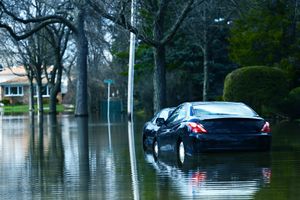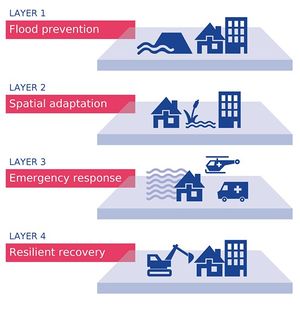PR 00152: verschil tussen versies
Geen bewerkingssamenvatting |
Geen bewerkingssamenvatting |
||
| Regel 16: | Regel 16: | ||
'''Emergency response (layer 3):''' Layer 3 refers to all temporary measures that can be taken in case of a actual flood threat. | '''Emergency response (layer 3):''' Layer 3 refers to all temporary measures that can be taken in case of a actual flood threat. | ||
'''Resilient recovery (layer 4):''' Layer 4 refers to | '''Resilient recovery (layer 4):''' Layer 4 refers to the resilient recovery after a flood event. See also 'resilience' and 'recovery'. | ||
'''Flood Resilience Rose:''' The Flood Resilience Rose, or FRR, is a self-assessment tool to analyze the resilience to flooding in the specific FRAMES pilot sites. It has been developed by the University of Oldenburg to support the pilot coordinators in: | '''Flood Resilience Rose:''' The Flood Resilience Rose, or FRR, is a self-assessment tool to analyze the resilience to flooding in the specific FRAMES pilot sites. It has been developed by the University of Oldenburg to support the pilot coordinators in: | ||
| Regel 26: | Regel 26: | ||
[[Bestand:Multi-Layered Safety visualization.jpg|gecentreerd|miniatuur]] | [[Bestand:Multi-Layered Safety visualization.jpg|gecentreerd|miniatuur]] | ||
'''Risk:''' the {{Cite|resource=Bestand:SYRAR5-Glossary en.pdf|name=IPCC (2014)|dialog=process-file-dialog}} defines risk as follows: | '''Resilience:''' The {{External link|resource=Resource Hyperlink 00497|name=UNDRR|dialog=process-linkwebsite-dialog}} describes this term as follows: "the ability of a system, community or society exposed to hazards to resist, absorb, accommodate to and recover from the effects of a hazard in a timely and efficient manner, including through the preservation and restoration of its essential basic structures and functions"({{Cite|resource=Bestand:7817 UNISDRTerminologyEnglish.pdf|name=UNISDR, 2009|dialog=process-file-dialog}}). | ||
'''Recovery:''' The {{External link|resource=Resource Hyperlink 00497|name=UNDRR|dialog=process-linkwebsite-dialog}} describes this term as follows: '''"'''The restoration, and improvement where appropriate, of facilities, livelihoods and living conditions of disaster-affected communities, including efforts to reduce disaster risk factors" ({{Cite|resource=Bestand:7817 UNISDRTerminologyEnglish.pdf|name=UNISDR, 2009|dialog=process-file-dialog}}). | |||
'''Risk:''' the {{Cite|resource=Bestand:SYRAR5-Glossary en.pdf|name=IPCC (2014)|dialog=process-file-dialog}} defines risk as follows: "The potential for adverse consequences where something of value is at stake and where the occurrence and degree of an outcome is uncertain. In the context of the assessment of climate impacts, the term risk is often used to refer to the potential for adverse consequences of a climate-related hazard, or of adaptation or mitigation responses to such a hazard, on lives, livelihoods, health and well-being, ecosystems and species, economic, social and cultural assets, services (including ecosystem services), and infrastructure. Risk results from the interaction of vulnerability (of the affected system), its exposure over time (to the hazard), as well as the (climate-related) hazard and the likelihood of its occurrence." | |||
'''Risk assessment:''' The qualitative and/or quantitative scientific estimation of risks ({{Cite|resource=Bestand:SR15 AnnexI Glossary.pdf|name=IPCC, 2018|dialog=process-file-dialog}}). | '''Risk assessment:''' The qualitative and/or quantitative scientific estimation of risks ({{Cite|resource=Bestand:SR15 AnnexI Glossary.pdf|name=IPCC, 2018|dialog=process-file-dialog}}). | ||
Versie van 16 jul 2019 11:38
In this glossary, the often used terms, concepts and tools in this project are described in alphabetical order. The glossary explains how we used the term, concept or tool in the context of this project and, if possible, links to other sites or articles where more information can be found.
Flooded cars (source: www.freepik.com)
Adaptation: The IPCC defines adaptation as: ‘‘Adjustment in natural or human systems in response to actual or expected climatic stimuli or their effects, which moderates harm or exploits beneficial opportunities’’ ( McCarthy et al., 2001)
Adaptive capacity: this concept is defined by the IPCC ( McCarthy et al., 2001) and the Millennium Ecosystem Assessment (2006) as follows: "The ability of a system to adjust to climate change (including climate variability and extremes) to moderate potential damages, to take advantage of opportunities, or to cope with the consequences."
Critical infrastructure: the European Programme for Critical Infrastructure Protection (EPCIP) defines critical infrastructure as " Physical and information technology facilities, networks, services and assets that, if disrupted or destroyed, would have a serious impact on the health, safety, security or economic well-being of citizens or the effective functioning of governments in EU States. Critical infrastructures extend across many sectors of the economy, including banking and finance, transport and distribution, energy, utilities, health, food supply and communications, as well as key government services (COM, 2004).
Impact Assessment: Impact Assessment (IA) simply defined is the process of identifying the future consequences of a current or proposed action. The “impact” is the difference between what would happen with the action and what would happen without it. More information can be found here: International Association for Impact Assessment (IAIA).
Flood prevention (layer 1): Layer 1, the layer of prevention, consists of of all permanent measures that reduce the probability of a flood.
Spatial adaptation (layer 2): Layer 2, the layer of spatial adaptation, refers to all types of spatial solutions measures (to be) taken to decrease the loss due to flooding.
Emergency response (layer 3): Layer 3 refers to all temporary measures that can be taken in case of a actual flood threat.
Resilient recovery (layer 4): Layer 4 refers to the resilient recovery after a flood event. See also 'resilience' and 'recovery'.
Flood Resilience Rose: The Flood Resilience Rose, or FRR, is a self-assessment tool to analyze the resilience to flooding in the specific FRAMES pilot sites. It has been developed by the University of Oldenburg to support the pilot coordinators in:
- systematically assessing and communicating strengths and weaknesses of the current flood risk management approach in their specific target site, and thereby;
- providing a tool to systematically analyze and improve the resilience to flooding in their target site through the implementation of the multi-layer safety approach.
More information can be found in this document about the FRR, written by the researchers from the University of Oldenburg who developed it.
Multi-Layered Safety / Multi-Layered Water Safety (MLS / MLWS): Multi-layered safety is an integrated flood risk management concept based on flood probability reduction through prevention (layer 1: dikes) but also on minimizing the consequences (should a flood occur) through spatial solutions (flood-proofing or elevating houses, re-locating), crisis management (evacuation, warning systems), and recovery (layers 2-4). It has been introduced in the Netherlands in 2009 following the European Flood Risk Directive adopted in 2007 (Hoss et al., 2011; Sophronides et al., 2016). This concept is depicted in the illustration below:
Resilience: The UNDRR describes this term as follows: "the ability of a system, community or society exposed to hazards to resist, absorb, accommodate to and recover from the effects of a hazard in a timely and efficient manner, including through the preservation and restoration of its essential basic structures and functions"(UNISDR, 2009).
Recovery: The UNDRR describes this term as follows: "The restoration, and improvement where appropriate, of facilities, livelihoods and living conditions of disaster-affected communities, including efforts to reduce disaster risk factors" (UNISDR, 2009).
Risk: the IPCC (2014) defines risk as follows: "The potential for adverse consequences where something of value is at stake and where the occurrence and degree of an outcome is uncertain. In the context of the assessment of climate impacts, the term risk is often used to refer to the potential for adverse consequences of a climate-related hazard, or of adaptation or mitigation responses to such a hazard, on lives, livelihoods, health and well-being, ecosystems and species, economic, social and cultural assets, services (including ecosystem services), and infrastructure. Risk results from the interaction of vulnerability (of the affected system), its exposure over time (to the hazard), as well as the (climate-related) hazard and the likelihood of its occurrence."
Risk assessment: The qualitative and/or quantitative scientific estimation of risks (IPCC, 2018).
Self-Assessment: According to Merriam-Webster, self-assessment is "the act or process of analyzing and evaluating oneself or one's actions".
Vulnerability: The often cited IPCC-definition (by McCarthy et al., 2001) of vulnerability is"... the degree to which a system is susceptible to, and unable to cope with, adverse effects of change, including variability and extremes. Vulnerability is a function of the character, magnitude, and rate of change and variation to which a system is exposed, its sensitivity, and its adaptive capacity." More on this can be found in Adger (2006).


